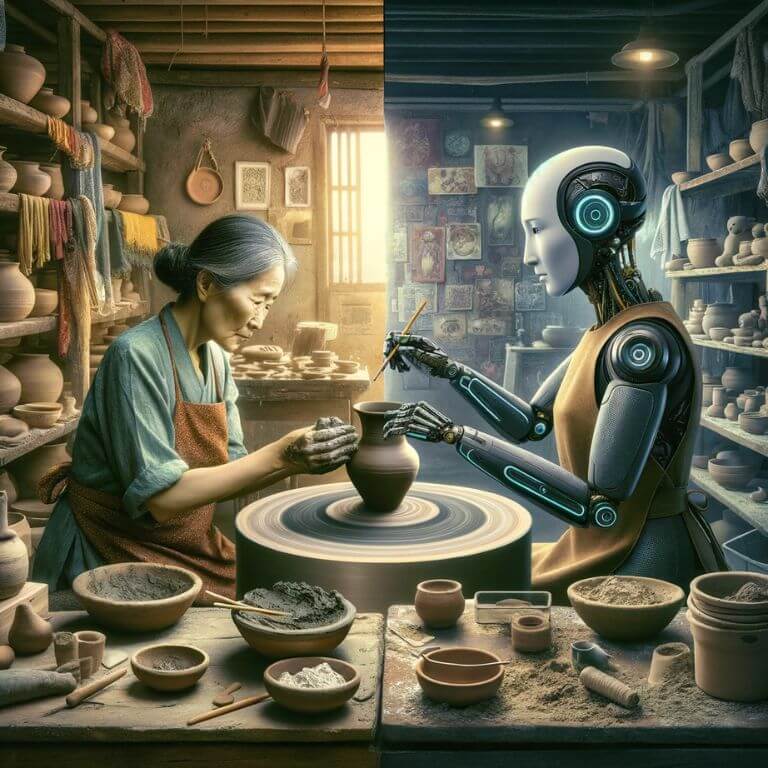AI in the Luxury Craftsmanship Sector

AI’s Creative Power: A New Tool for Luxury Artisans
AI is making a growing impact in the creative industries, enabling the creation of intricate designs, forecasting trends, and enhancing production processes. Yet, despite its impressive advancements, AI will never replace true craftsmanship. Instead, it will serve as a powerful tool. It will be one that sparks new ideas, offers starting points, and pushes creative boundaries. True artistry, however, will always remain in human hands, as history has already demonstrated.
History Repeats Itself: From Industrialisation to Automation
The Industrial Revolution ushered in mass production, making goods more affordable and widely available. Yet, rather than eliminating craftsmanship, this era sparked a revival of handmade artistry. As factory-produced furniture and textiles flooded the market, the tastes of the elite began to shift. They began favouring handcrafted goods that reflected individuality and skill. This shift led to the Arts and Crafts Movement, led by figures such as William Morris. In this movement, people began to reject industrial uniformity in favour of traditional techniques. The movement emphasised the beauty of imperfection and the human touch, making a statement that mass production could not replicate it. Soon, middle-class households began incorporating block-printed floral wallpapers and furniture that was intentionally left unfinished, a design choice that highlighted its handmade origins. This historical pattern is repeating itself today.
As AI-generated designs become more widespread, the value of handmade work is on the rise. In an increasingly automated world, consumers are gravitating toward craftsmanship as a symbol of authenticity. This shift is not just speculative—it’s already being recognised by experts in the field. Krzysztof Pelc, who has studied the impact of automation on creative fields, argues that “whenever automation appears set to replace an artisanal skill, the market responds by revaluing the human touch.” AI, rather than erasing craftsmanship, is making it more desirable, pushing artisans to lean further into their distinctiveness. Sam Altman, the founder of OpenAI, echoes this sentiment. He states, “AI will not replace creativity. It will enhance it, offering new ways to explore ideas, but the fundamental spark of human ingenuity remains irreplaceable.”
AI as a Creative Partner: Elevating, Not Replacing, the Artisan
Rather than eliminating artisanship, AI is reshaping the landscape of luxury craftsmanship by providing new tools that amplify human creativity. While AI can quickly generate countless design variations, it cannot replicate the cultural significance, personal interpretation, or subtle imperfections that define handmade objects. These human qualities are what make handcrafted works irreplaceable in a world increasingly driven by automation. Thus, artisans remain at the heart of the creative process, using AI as a source of inspiration to push the boundaries of what is possible. They are able to retain the distinctiveness that makes their craft unique.
The true challenge, then, lies not in whether AI will replace artisans but how it will be integrated into the creative process. If used as a collaborator rather than a replacement, AI has the potential to preserve and enhance traditional craftsmanship. In fact, as technological advancements continue, the value of human-created art will only increase. Just as past technological changes have sparked a greater appreciation for handmade goods, today’s AI revolution will elevate the worth of craftsmanship in an increasingly automated world.
In the future, the most desirable works will be those that merge the efficiency of AI with the irreplaceable depth of human skill. It is not the machine that will define the future of luxury craftsmanship, but rather the seamless integration of human ingenuity with technological progress—a testament to the enduring value of the handmade in a world that increasingly celebrates the authentic.
By April Clark
